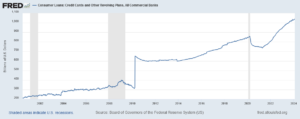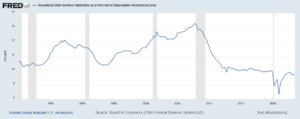February 21, 2024
The media are pushing the economy is terrible story pretty much 24-7. They refuse to let the strong labor market and rapid real wage growth get in their way. They seem to want everyone to think things are really bad, in spite of a 24-month stretch of below 4.0 percent unemployment and a sharp reduction in wage inequality since the pandemic.
The latest item in this effort was a New York Times piece about how the economy is rigged. It told readers about the bad times exemplified by an explosion of credit card debt. While credit card debt is rising rapidly, it is not quite the horror story the piece would have you believe.
Credit card debt virtually stopped growing in 2020-22. There were two reasons. First, the pandemic checks meant that many households were flush with cash and had no reason to borrow on their credit card.
The second reason is that we had an unprecedented boom in mortgage refinancing, with more than 14 million people taking advantage of the low rates available during these years. Many of these households borrowed extra cash when they refinanced, meaning they had no reason to borrow on their credit cards.
Those who didn’t do cash-out refinancing saved an average of $2,500 a year on interest. Somehow this fact has gone almost unnoticed among those commenting on the economy.
With the cash people saved in the pandemic getting run down, and the refinancing window closed due to the jump in mortgage rates, people are again turning to credit cards. But we are just back to roughly our pre-pandemic trend, as shown below. (By the way, anyone who says that credit card debt is at a record high is just trying to tell you that they know nothing about the economy. Just like GDP and income, credit card debt is almost always hitting a record high.)

If we are worried about the burden of interest payments on family budgets, then we can look at the ratio of debt service to income, which includes the burden of all loans, not just credit cards. Here’s the picture.

As can be seen, instead of the horrible burden story, the ratio is near a four-decade low, with the pandemic years being the only time when it was lower.
To be clear, tens of millions of people are struggling to pay their rent and put food on the table, but that was also true when Donald Trump was in the White House. In those years, the NYT and other major media outlets did not feel the need to constantly run pieces saying how awful the economy was.
I will also add that the economy is in fact rigged, but not in ways that the New York Times will let people talk about in its pages. The government grants patent and copyright monopolies that make folks like Bill Gates incredibly rich and drugs incredibly expensive. Our system of corporate governance is a cesspool, with top executives making tens of millions annually at the expense of their companies and hugely skewing wage patterns throughout the economy. The bloated financial system siphons hundreds of billions annually from the rest of us and hands it to hedge fund and private equity tycoons.
We could structure the economy differently so that less of the benefits of growth go to those at the top. But the major media outlets do not want to have that sort of discussion. They just want to tell people that things are bad under Biden.







Comments